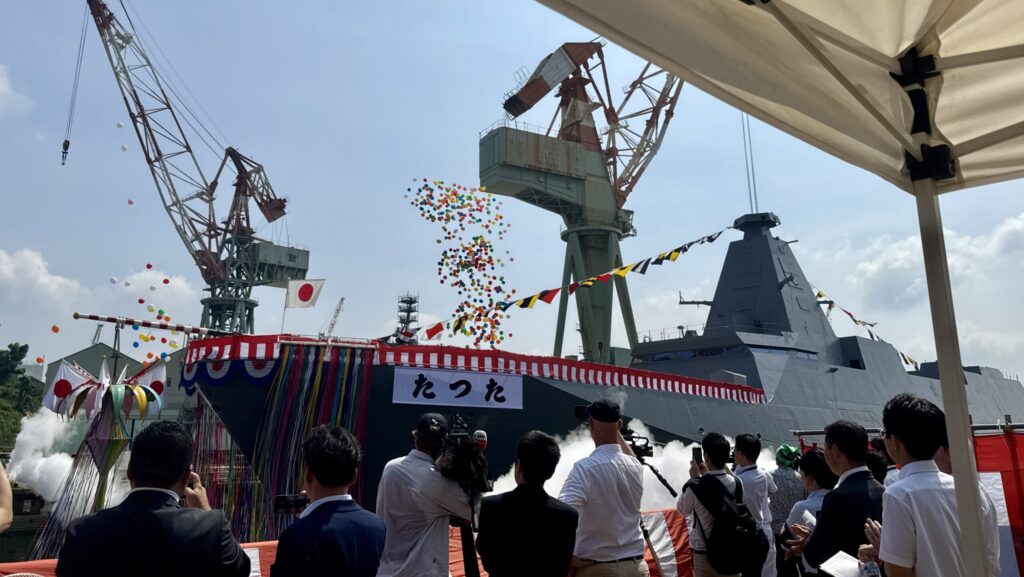
NAGASAKI — Japan is making a concerted effort to establish Australia as the inaugural customer for its advanced Mogami frigate. In an uncommon move, the traditionally reserved Ministry of Defense has flown Australian journalists to Nagasaki to showcase the capabilities of the Mogami, underscoring the strategic importance of this potential deal.
During a three-day briefing, reporters were introduced to the ship’s sophisticated systems and Japan’s vision for a strengthened defense and industrial partnership with Australia. Mitsubishi Heavy Industry, the shipbuilder, has committed to including all intellectual property and providing parts and support for the frigate’s projected 40-year lifespan.
Strategic Diplomatic Efforts
In a clear demonstration of Japan’s commitment, Defense Minister Gen Nakatani attended the launch of the 11th Mogami-class ship. He personally engaged with the reporters, emphasizing the significance of this initiative as part of an “all-Japan government approach” to exporting Japan’s first major weapon system since World War II.
Nakatani highlighted that acquiring the Mogami would enhance Australia’s “sustainment and resilience” in the Indo-Pacific region. This move is part of Japan’s broader strategy to deepen defense ties with Australia, a key ally in the region.
Competition and Construction Plans
Japan is competing with Germany’s ThyssenKrupp Marine Systems (TKMS) to supply Australia with 11 new frigates, intended to replace the aging ANZAC-class ships. The construction plan involves building the first three ships in the winning company’s country, with the subsequent eight to be constructed in Western Australia.
The Australian Defense Force and the Ministry of Defense are currently engaged in a Comprehensive Risk Reduction process with the two companies. A decision by the National Security Council is anticipated soon, followed by an official Request For Tender. The final selection is expected by the end of the year, with the first ship’s delivery projected for 2029.
Technical Specifications and Innovations
The Mogami frigate is designed to meet Australia’s requirement for off-the-shelf purchase. It features a 32-cell Vertical Launch system, double that of TKMS’s initial offer, and is equipped with two diesel engines to power its advanced Anti-Submarine Warfare systems, mine warfare capabilities, and sophisticated radar and sensors.
One of the standout features is the ship’s Combat Information Center (CIC), which is heavily protected and capable of being managed by a minimal crew. This design choice addresses Australia’s challenges in recruiting enough sailors, as the Mogami requires a crew of 90 compared to up to 160 on similar ships.
“We the Japanese government will guarantee that the whole project, and all the contracts will go smoothly so that there will not be any delay to the project,” stated Osamu Nishiwaki, a top official at Japan’s Acquisition, Technology and Logistics Agency.
Stealth and Efficiency
The Mogami frigate boasts a reduced radar cross section and stealth features, including minimized infrared and electromagnetic signatures. Its design, with bent angles reminiscent of stealth aircraft, enhances its operational effectiveness.
Additionally, the ship can dock without tugs and has a shallow draft, a feature developed in response to the 2011 tsunami that impacted northeastern Japan’s ports. This adaptability further underscores the vessel’s strategic value.
Implications and Future Prospects
Japan’s efforts to secure Australia as a customer for the Mogami frigate are indicative of its broader ambitions to expand its defense exports and strengthen regional alliances. The outcome of this competition will not only affect Japan’s defense industry but also have significant implications for regional security dynamics.
As the decision deadline approaches, both Japan and Germany are intensifying their efforts to secure the contract. The successful bidder will play a crucial role in shaping Australia’s naval capabilities for decades to come.
With the final decision expected by the end of the year, the defense industries of both nations are keenly awaiting the outcome, which could set a precedent for future international defense collaborations.







